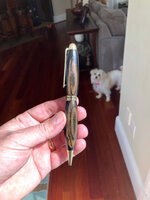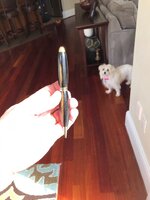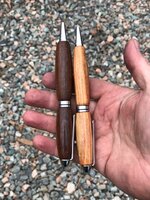Here is what I do, based on what I have read from others, refined with personal experimentation:
* Turn the blanks to a very close match with the bushings or desired caliper dimensions. I use a round carbide and a gentle touch to do the final matching. Your fingers (or the calipers) are the best test. Be careful and pay attention, the round tip can cut a tiny cove in the blank behind the bushing. The goal is to get a smooth shape with the tools, not the sandpaper.
* Cut up old rags from the garage into a bunch of small pieces. I cut 'em up with scissors. We have a bin in the garage full of old t-shirts, etc.
* Before sanding, rotate the tool rest completely out of the way or remove it. Mount the blanks on non-stick plastic bushings. This exposes the blanks end-to-end, and eliminates the concern that metal grains will be pulled from the bushings and ground into the blanks.
* Sanding should be mostly about finishing, not shaping. With each sanding, I run the lathe on a slow speed, and do not spend more than a few seconds. I hold the strip behind the blanks, pinching the strip from above and below. Move the strip up and down and back and forth quickly as the blank turns. Do not pull very hard or you may bend your pen mandrel. Do not allow the sandpaper to roll over the ends of the blanks or you will round them and make them too small. Do not sand too much, or your blank will be smaller than the pen parts. This is where experience comes into play.
* Preserve the unused the top and bottom "pinch areas" of the sandpaper unused. Stop the lathe and use the pinch areas to sand along the length of the blanks with your right hand while you slowly rotate the blanks with your left hand on the rotator-wheel-thingy-on-the-left-side-of-your-lathe. Your goal is to remove or reduce the circular scratches. Inspect the ends carefully, that's where I usually find the "rings." When you sand the ends, don't let your sandpaper bend roll over the end of the blank.
* After EVERY sanding, make sure the lathe is off, then pick up a clean rag piece and wipe off all the dust and grit from the blanks. Throw the rag in the trash.
* If the blanks are plastic or finished with CA, then I do the same thing with all nine Micro-mesh pads, but I sand with them wet. (Wet sand with lathe turning slowly for only a few seconds, moving quickly back and forth, again laterally with lathe off while rotating the blank by hand, and then wipe with a clean rag.)
True confessions:
I don't always use a fresh rag piece for every wipe. Sometimes I am lazy and use the same rag piece for two or three "adjacent" grits, but never more than that. When you are done with one, throw it in the trash so you don't mix it up with clean ones.
I don't need to start at 150, especially with acrylics, but I do anyway. I can't explain why.
I am getting better at using the skew chisel, even on acrylics, but I still resort to the scrapers at the end. I always practice with the skew chisel when the rounded blank is large, but when I get close, I switch to the other tools - spindle gouge, rounded square carbide, and round carbide to do the final shaping and bushing matching. Someday soon I hope to shape a smooth pen with the skew chisel all the way.





